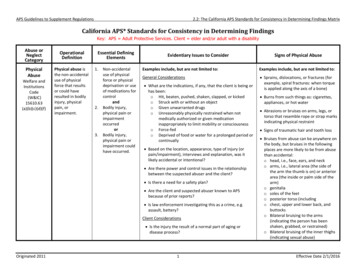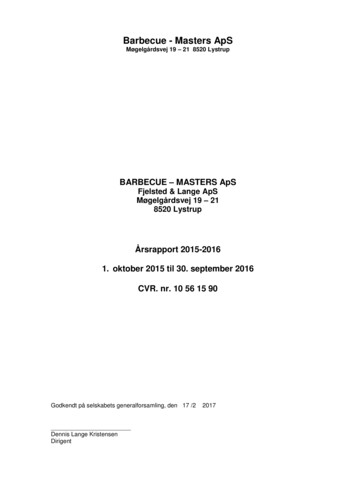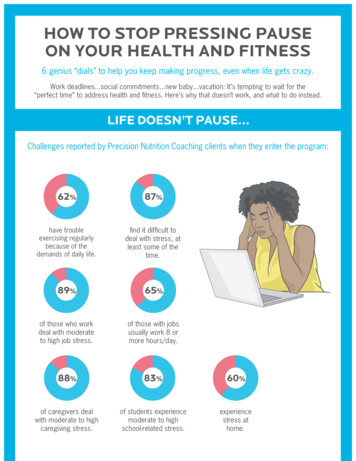
Transcription
APS Guidelines to Supplement Regulations2.2: The California APS Standards for Consistency in Determining Findings MatrixCalifornia APS* Standards for Consistency in Determining FindingsKey: APS Adult Protective Services. Client elder and/or adult with a disabilityAbuse orNeglectCategoryPhysicalAbuseWelfare erationalDefinitionPhysical abuse isthe non-accidentaluse of physicalforce that resultsor could haveresulted in bodilyinjury, physicalpain, orimpairment.Essential DefiningElements1.2.3.Non-accidentaluse of physicalforce or physicaldeprivation or useof medications forcontrolandBodily injury,physical pain orimpairmentoccurredorBodily injury,physical pain orimpairment couldhave occurred.Evidentiary Issues to ConsiderExamples include, but are not limited to:Examples include, but are not limited to:General Considerations Sprains, dislocations, or fractures (forexample, spiral fractures: when torqueis applied along the axis of a bone) What are the indications, if any, that the client is being orhas been:o Hit, beaten, pushed, shaken, slapped, or kickedo Struck with or without an objecto Given unwarranted drugso Unreasonably physically restrained when notmedically authorized or given medicationinappropriately to limit mobility or consciousnesso Force-fedo Deprived of food or water for a prolonged period orcontinually Based on the location, appearance, type of injury (orpain/impairment), interviews and explanation, was itlikely accidental or intentional? Are there power and control issues in the relationshipbetween the suspected abuser and the client? Is there a need for a safety plan? Are the client and suspected abuser known to APSbecause of prior reports? Is law enforcement investigating this as a crime, e.g.assault, battery?Client Considerations Is the injury the result of a normal part of aging ordisease process?Originated 2011Signs of Physical Abuse1 Burns from such things as: cigarettes,appliances, or hot water Abrasions or bruises on arms, legs, ortorso that resemble rope or strap marksindicating physical restraint Signs of traumatic hair and tooth loss Bruises from abuse can be anywhere onthe body, but bruises in the followingplaces are more likely to be from abusethan accidental:o head, i.e., face, ears, and necko arms, i.e., lateral area (the side ofthe arm the thumb is on) or anteriorarea (the inside or palm side of thearm)o genitaliao soles of the feeto posterior torso (includingo chest, upper and lower back, andbuttockso Bilateral bruising to the arms(indicating the person has beenshaken, grabbed, or restrained)o Bilateral bruising of the inner thighs(indicating sexual abuse)Effective Date 2/1/2016
APS Guidelines to Supplement RegulationsAbuse orNeglectCategory(continued)Physical ion2.2: The California APS Standards for Consistency in Determining Findings MatrixEssential DefiningElementsEvidentiary Issues to ConsiderSigns of Physical Abuse Is the client taking any medication that would make him/her bruise easily, such as prednisone, warfarin, or Plavix?1. Larger bruises—accidental bruises tendto be smaller than deliberate ones Is the client cognitively impaired?2. History of similar injuries, numeroussuspicious hospitalizations, and/oruntreated previous injuries Does the client use an assistive device for mobility? Does the client require assistance with ADLs? If the client is bruised, does he/she remember how he/she got the bruises? Are the suspected abuser’s and the client’s explanationsabout how the injury occurred consistent with oneanother? Is the explanation for the injury consistent with the factsthat the social worker observes, i.e., the physical location,the wounds, the timing, etc. match the explanation?Suspected Abuser Considerations Injuries in various stages of healingincluding multicolored bruises(indicating they occurred over time). Medical assessment and lab workincluding medical opinion on theresults Signs of malnutrition or dehydrationwithout illness-related cause Police arresting the accused for batteryor assault What access does the suspected abuser have to theclient/does the suspected abuser live with the client? Is the suspected abuser dependent, financially orotherwise, on the client? Does the suspected abuser have a substance or mentalhealth problem? Does the suspected abuser have a criminal record? Does the suspected abuser understand the doctor’sinstructions regarding the administration of medications,and/or use of restraints?Originated 20112Effective Date 2/1/2016
APS Guidelines to Supplement RegulationsAbuse orNeglectCategorySexual AbuseW&IC15610.63 (e)OperationalDefinitionSexual abuse isnonconsensualsexual contact ofany kind with aclient. It includes,but is not limited to: Unwantedtouching All types ofsexual assault orbattery such asrape, sodomy,and coercednudity Sexually explicitphotographing Forced exposureto pornography Unwanted sexualrelations with aspouse, partner,significant otheror anyone else.2.2: The California APS Standards for Consistency in Determining Findings MatrixEssential DefiningElements1. Evidence a sexualincident(s) orsituation(s)occurredand2. The incident orsituation isunwanted or nonconsensual innature.Evidentiary Issues to ConsiderExamples include, but are not limited to:General Considerations What are the indications, if any, that the client isbeing or has been:o Touched in an unwanted fashiono Raped, sodomized, or forced to take off his/herclotheso Photographed in a sexually explicit wayo Forced to look at pornographyo Pressured/forced to have unwanted sexualrelations with a spouse, partner, significant otheror anyone else. Are there power and control issues in the relationshipbetween the suspected abuser and the client? Is there a need for a safety plan? Are this client and suspected abuser known to APSbecause of prior reports? Is law enforcement investigating this as a crime (i.e.,sexual assault, sexual battery, rape, etc.)?Client Considerations Is the client able to consent to sexual activity? If so,did the client consent? Was the client coerced orpressured into the sexual act?Signs of Sexual AbuseExamples include, but are not limited to: Genital or anal pain, irritation or bleeding Bruising on external genitalia or innerthighs Difficulty walking or sitting Torn, stained or bloody underclothing Client’s intimate body parts are treatedroughly while receiving care, such as whenbeing cleaned or dressed. Client forced to watch pornography on thetelevision and/or computer Client is newly diagnosed with a sexuallytransmitted disease Medical assessment and lab work,including a medical opinion support thereport of sexual assault The dependent adult is pregnant Sudden, marked change in personality ordemeanor Does the client have family or friends to provideemotional support or to advocate on his/her behalf? Are there any changes in the client’s affect, tone ofvoice, or body language when in the suspectedabuser’s presence?Originated 20113Effective Date 2/1/2016
APS Guidelines to Supplement RegulationsAbuse orNeglectCategory(continued)Sexual AbuseW&IC15610.63 (e)OperationalDefinition2.2: The California APS Standards for Consistency in Determining Findings MatrixEssential DefiningElementsEvidentiary Issues to ConsiderSigns of Sexual AbuseSuspected Abuser Considerations What access does the suspected abuser have to theclient/does the suspected abuser live with the client? Is the suspected abuser dependent, financially orotherwise, on the client? Does the suspected abuser have a substance ormental health problem? Does the suspected abuser have a criminal record,specifically has the suspected abuser been arrestedfor any sexual crimes or for a transgression of asexual nature?Originated 20114Effective Date 2/1/2016
APS Guidelines to Supplement RegulationsAbuse use is theillegal orimproper useof a client’sfunds, propertyor epersuasionthat causesanother personto act orrefrain fromacting byovercomingthat person’sfree will andresults ininequity.Refer to W&IC15610.702.2: The California APS Standards for Consistency in Determining Findings MatrixFunds,property orassetsbelonging tothe clientHave siblythrough theuse of undueinfluence*and3.For a wrongfuluse (likely tobe harmful tothe client)or4.With intent todefraud.Evidentiary Issues to ConsiderExamples include, but are not limited to:General Considerations What are the indications, if any, that the client is being or hasbeen financially exploited by someone, e.g.o Cashing a client’s check or using/misusing a client’s debitcard without authorization or permissiono Forging the client’s signatureo Misusing or stealing the client’s money or possessionso Taking the client’s funds or property by using undueinfluenceo Coercing or deceiving the client into signing a documente.g., contracts, real estate/reverse mortgage/deeds, trustsor willo Improperly executing the duties of conservatorship,guardianship, or powers of attorney Scams such as ID theft, telemarketing/lottery/ investment/annuity/sweetheart/ grandparent scams, trust mills,unlicensed contractors Who is making the financial decisions and are the decisionsbeing made in the client’s best interest? Does the suspected abuser exploit the client’s incapacitationsuch as when the client is tired, ill, or taking mentallyimpairing medications? Is the suspected abuser targeting vulnerabilities (e.g. takes ormoves walker, wheelchair, glasses, dentures if the client doesnot comply with demands for money or signatures or takesadvantage of confusion)?Signs of Financial AbuseExamples include, but are not limited to: Unpaid bills, eviction notices or notices todiscontinue utilities Withdrawals from bank accounts ortransfers between accounts that theclient cannot explain or the explanationsuggests coercion or manipulation of theclient Bank statements and canceled checks nolonger delivered to the client’s home New “best friends” who take an interestin the client’s finances Legal documents (i.e., powers of attorney)the client did not understand whensigning or understood but were signedunder duress or because of manipulation Unusual activity in the client’s bankaccounts, including large, unexplainedwithdrawals, frequent transfers or ATMwithdrawals Changes in spending or financialmanagement habits (e.g., has always beena saver and is now spending a lot) A suspected abuser’s excessive interest inthe amount of money spent on the client Missing belongings or property Suspicious signatures on checks or otherdocumentsOriginated 20115Effective Date 2/1/2016
APS Guidelines to Supplement RegulationsAbuse orNeglectCategoryOperationalDefinition2.2: The California APS Standards for Consistency in Determining Findings MatrixEssentialDefiningElementsEvidentiary Issues to ConsiderFinancialAbuse Did the suspected abuser take the property or moneyknowing such conduct is harmful to the client or with theintent to defraud?W&IC15610.30 Did the suspected abuser fail to return the property/moneyupon demand by the client or his/her representative?(continued)3. Are there any indicators of undue influence, such as:oDoes the client have limited social contacts and is thesuspected abuser capitalizing on his/her loneliness &vulnerability?oIs the suspected abuser attempting to make the clientemotionally dependent?oIs the suspected abuser trying to isolate the client?oIs the suspected abuser attempting to take control ofthe client’s life and affairs, including personal care,medical attention, food, daily activities, and informationas well as finances?oIs the suspected abuser creating an “us against them”mentality?oIs the suspected abuser exploiting his/her emotionalrelationship with client? Is the client susceptible to threats of abandonment? Are the client and suspected abuser known to APS because ofprior reports? Is law enforcement investigating this as a crime?Client Considerations Does the client have mobility problems and physical ailmentsthat make him/her more dependent on others? Does the client have cognitive/memory impairments, drug orsubstance abuse problems, or mental health problems thatmight impair his/her capacity?Originated 20116Signs of Financial Abuse Absence of documentation aboutfinancial arrangements Implausible or inconsistent explanationsby the client, caregiver, or suspectedabuser about the client’s finances Client’s ignorance or lack ofunderstanding regarding financialarrangements made on his/her behalf The client is not receiving care nor ishis/her living arrangementscommensurate with his/her assets. The scope/quality of care the client hasbeen receiving is reduced The suspected abuser cues or promptsthe client or interrupts the client ininterviews There are contradictions orinconsistencies in behavior, statements,or history between the client and thesuspected abuser, the client and theenvironment, between chronologies, andbetween before and after histories. Changes in the ownership of property andother assets. Client has received a foreclosure notice. Client’s service providers were changedafter the suspected abuser becameinvolved in the client’s life.Effective Date 2/1/2016
APS Guidelines to Supplement RegulationsAbuse 0.30OperationalDefinition2.2: The California APS Standards for Consistency in Determining Findings MatrixEssentialDefiningElementsEvidentiary Issues to Consider4. Are the client’s needs being adequately met—medical,environmental, etc., or is the suspected abuser benefitingfrom the client’s resources while the client does not have thenecessary care, supplies or affordable amenities?5. Have there been any changes in the client’s contact withhis/her social network?6. Are there any changes in the client’s affect, tone of voice, orbody language when in the suspected abuser’s presence?Signs of Financial Abuse Access to the client is limited by thesuspected abuser. The client has a relatively sudden andmarked change in behavior, such as:seems depressed or anxious, stops goingout, avoids contact with family andfriends, etc7. What changes have occurred in the client’s life and livingsituation since the suspected abuser became actively involvedwith the client?8. Is the client depressed, anxious, or fearful?Suspected Abuser Considerations Does the suspected abuser resist or try to interfere with theclient being interviewed alone? What access does the suspected abuser have to theclient/does the suspected abuser live with the client? Is the suspected abuser dependent, financially or otherwise,on the client? What was the suspected abuser’s financial history beforebecoming actively involved with the client? Does the suspected abuser have a substance or mental healthproblem? Does the suspected abuser have a criminal record?Originated 20117Effective Date 2/1/2016
APS Guidelines to Supplement RegulationsAbuse nalDefinitionEssential DefiningElementsNeglect isdefined as therefusal orfailure to fulfillany part of aperson’sobligations orduties to aclient.1. Negligent failure totake action,whether intentionalor unintentional.2. Could be: Caretaker Care Custodian* Person providingservices (e.g.home healthnurse) Person in aposition of trustor fiduciary (e.g.POA)3. Level of care orservice is what areasonable personwould provide.* “Care custodian”means anadministrator or anemployee of a publicor private facility oragency, or personsproviding care orservices for elders ordependent adults (forfull definition, refer toWIC 15610.17)Originated 20112.2: The California APS Standards for Consistency in Determining Findings MatrixEvidentiary Issues to ConsiderExamples include, but are not limited to:General Considerations What are the indications, if any, that the client is being or hasbeen neglected because:o A person who has a fiduciary responsibility to the client hasfailed of to insure the client is receiving adequate careo An in-home service provider has failed to provide the clientwith necessary care.o The client is not being provided with necessities of life suchas food, water, clothing, shelter, personal hygiene,medicine, comfort personal safety and other essentials byan individual who has an implied or an agreed-uponresponsibility to the client.o A care custodian is not providing the client with the goodsor services that are necessary to avoid physical harm ormental suffering. Have issues of neglect resulted in physical or emotional harmor hospitalization (e.g. malnutrition, dehydration, decubitusulcers, depression, decrease in quality of life, socialwithdrawal, etc)?Signs of NeglectExamples include, but are not limited to: Client has bad hygiene and smells offoul odor. Client has long, dirty, and unkemptfinger and toe nails. The suspected abuser is creating arisk to the client’s health byo not providing the prescribedmedication properly (e.g. diabetesor high blood pressure)o not providing transportation tomedical/mental health visitso not complying with the client’smedical appointments Client’s home is in dilapidatedcondition. Client is living in hoarding conditions. Client has been living with no runningwater, heat, or electricity. Is the client being neglected due to retaliation/family dynamics(e.g. son or daughter unhappy with their upbringing)? Client is found soiled and the housesmells of feces. What is the level of stress in the in the household due tofinancial, family, marital, or health problems? The suspected abuser refuses todress the client or dresses the clientinappropriately. Are the client and suspected abuser known to APS because ofprior reports? Is law enforcement investigating this as a crime?8 The suspected abuser fails to protectthe client from health and safetyhazards (e.g. allowing pets todefecate and urinate in the home).Effective Date 2/1/2016
APS Guidelines to Supplement RegulationsAbuse (b)OperationalDefinitionEssential DefiningElements2.2: The California APS Standards for Consistency in Determining Findings MatrixEvidentiary Issues to ConsiderClient Considerations Does the client have diagnosed dementia, or is there evidenceto suggest that there is an issue with client’s capacity? Has the client refused medical treatment because he/she relieson treatment by spiritual means through prayer alone in lieu ofmedical treatment? Is this the reason proffered by for a lack ofmedical care? If so, this would not be considered neglect.Signs of Neglect Deprivation by care custodian: WI&C15610.35. "Goods and servicesnecessary to avoid physical harm ormental suffering" include, but are notlimited to, all of the following:(a) The provision of medical care forphysical and mental health needs. Does the client have a mental illness or drug or alcoholproblems that make providing care difficult?(b) Assistance in personal hygiene. Does the client have an abusive or dominating personality?(d) Adequately heated and ventilatedshelter. Does the client resist help?Suspected Abuser Considerations Is the neglect intentional or unintentional? Did the suspected abuser knowingly deprive the client of food,shelter, clothing, and/or medication? Did the suspected abuser neglect the client for personal gain(e.g. to save money or inheritance)? Does the suspected abuser have a drug/ alcohol or mentalhealth problem that impairs his/her ability to make sounddecisions for himself and/or for the client? Is the suspected abuser overwhelmed with his/her duties orlacks the training to provide appropriate care?(c) Adequate clothing.(e) Protection from health and safetyhazards.(f) Protection from malnutrition,under those circumstances wherethe results include, but are notlimited to, malnutrition anddeprivation of necessities orphysical punishment.(g) Transportation and assistancenecessary to secure any of theneeds set forth in subdivisions (a)to (f), inclusive. Does the suspected abuser have Durable Power of Attorneyover client? Did the suspected abuser fail to seek or provide neededmedical treatment as promptly as a reasonable person would?Originated 20119Effective Date 2/1/2016
APS Guidelines to Supplement Regulations2.2: The California APS Standards for Consistency in Determining Findings Matrix.Abuse (b)OperationalDefinitionEssential DefiningElementsEvidentiary Issues to ConsiderSigns of Neglect What access does the suspected abuser have to theclient/does the suspected abuser live with the client? Is the suspected abuser dependent, financially or otherwise, onthe client? Does the suspected abuser have a criminal record? If a licensed agency is responsible, is a cross report warranted?Originated 201110Effective Date 2/1/2016
APS Guidelines to Supplement RegulationsAbuse orNeglectCategorySelf NeglectW&IC15610.57(a)(2), (b)(5)OperationalDefinitionSelf-Neglect isan adult’srefusal orfailure toperformessential selfcare tasks.2.2: The California APS Standards for Consistency in Determining Findings MatrixEssentialDefiningElements1. Client is refusingor failing toexercise selfcare.and2. The level of selfcare is notreasonable.Evidentiary Issues to ConsiderExamples include, but are not limited to:General Considerations What are the indications, if any, that the client’s self care is or hasbeen inadequate, for example:oNot obtaining essential food, clothing, shelter, and medical careoroNot maintaining physical health, mental health, financial health,or general safety? Is the client’s chronic homelessness or chronic substance abuse thesole basis for the referral? If so, the report might not be accepted asself-neglect. Would the client more appropriately served by another system ofcare/agency (e.g. mental health services, Regional Center, homelessservices, etc.)? If so, the report might be referred to that agency. Is this client known to APS because of prior reports?Client Considerations Is the client’s failure to get medical care or treatment because he/sherelies on treatment by spiritual means through prayer alone in lieu ofmedical treatment? If so, this is not considered neglect. Is the client’s failure to perform essential self care a result of poorcognitive functioning, mental limitation, substance abuse, or chronicpoor health? Has the client’s health deteriorated or has he/she developed chronichealth problems due to the refusal of medical services? Does the client exhibit hoarding behavior, including animal hoarding?Originated 201111Signs of Self-NeglectExamples include, but are notlimited to: Client is unable/fails/refuses totake in adequate amounts offood and fluids. Client has a noticeable weightloss or is showing signs ofmalnutrition. Client’s physical appearanceshows sunken eyes. Client is eating food that ispotentially unsafe or harmful tohis/her health condition. Client is unable/fails/refuses todress him/herself appropriately. Client is unable/fails/refuses toattend to personal hygiene andsmells of foul odor. Client’s home is unclean and/orhazardous (e.g., soiled and smellsof feces or no running water,heat, or electricity). Client is unable/fails/refusesmedical care and/or mentalhealth services. Client is unable/fails/refuses totake his/her medication.Effective Date 2/1/2016
APS Guidelines to Supplement RegulationsAbuse orNeglectCategory(continued)Self NeglectW&IC15610.57(a)(2), (b)(5)OperationalDefinition2.2: The California APS Standards for Consistency in Determining Findings MatrixEssentialDefiningElementsEvidentiary Issues to Consider Is the self-neglect a result of lack of awareness or inability? Is the client at any risk due to his/her behavior, such as risk of evictionor having his/her housing condemned by environmental health? What resources were available to the client and how reasonable is itthat the client could have accessed them? If resources were available combined with functional ability andbalancing safety – could safety be maintained?Signs of Self-Neglect Bills are unpaid or payments arelate. Utilities are shut off or at risk ofbeing shut off. Client is unable/fails/refuses toprotect his/her money fromscams or others. Is the client able to manage his/her finances?Originated 201112Effective Date 2/1/2016
APS Guidelines to Supplement RegulationsAbuse orNeglectCategoryPsychologicalAbuse Psychologicalabuse is theinfliction offear, anguish,agitation, orotheremotionaldistressthrough verbalor nonverbalacts.2.2: The California APS Standards for Consistency in Determining Findings MatrixEssentialDefiningElements1. Emotionaldistressexhibitedby clientand2. Theemotionaldistress is aresult ofsomeoneelse’sbehavior/actions.Evidentiary Issues to ConsiderExamples include, but are not limited to:General Considerations What are the indications, if any, that the client is being or has beenoVerbally assaulted, insulted, and threatenedoIntimidated, humiliated (e.g., treated as an infant), and harassed.oGiven the "silent treatment" or had affection withdrawnoTold misleading comments made with malicious intent to inflictemotional harm. Are there power and control issues in the relationship between thesuspected abuser and the client? Are the client and suspected abuser known to APS because of prior reports?Client Considerations Does the client have cognitive impairments that cause him/her to exhibitbehaviors that could be misinterpreted as emotional distress caused byothers? Does the client have diagnosed dementia, mental illness, or is thereevidence to suggest that there is an issue with client’s capacity? Is the response of others to the client’s cognitive impairment causing theclient additional emotional distress?Signs of Psychological AbuseExamples include, but are notlimited to: Suspected abuser observed orheard yelling at, belittling,and/or threatening the client. Suspected abuser using theclient’s pet to distress the clientby restricting access to theanimal, making threats about theanimal, etc. Client looks depressed. Client is confused or disoriented. Client is showing signs ofconfinement. Suspected abuser lying to theclient deliberately to upsethim/her. Client being intimidated/harassed by othersSuspected Abuser Considerations Is the suspected abuser dependent, financially or otherwise, on the client? Does the suspected abuser have a substance or mental health problem? Does the suspected abuser have a criminal record?Originated 201113Effective Date 2/1/2016
APS Guidelines to Supplement RegulationsAbuse orNeglectCategoryOperationalDefinitionAbandonment AbandonmentW&IC15610.05is intentionallyleaving orforsaking aclientEssential Defining Elements2.2: The California APS Standards for Consistency in Determining Findings MatrixEvidentiary Issues to Consider1. Desertion is deliberateExamples include, but are not limited to:2. Could be:General Considerations Caretaker Care Custodian* What are the indications, if any, that the clienthas been abandoned? Person providing services (e.g.home health nurse) Are the client and suspected abuser known toAPS because of prior reports? Person in a position of trust orfiduciary (e.g. POA) Is law enforcement investigating this as a crime?3. Reasonable person wouldcontinue to provide care andcustody. Is the abandonment part of a threat? Is there a risk to the client’s safety because ofwhere he/she was left?Client Considerations*“‘Care custodian’ means anadministrator or an employee of apublic or private facility or agency,or persons providing care or servicesfor elders or dependent adults (forfull definition, refer to WIC15610.17) Is the client cognitively impaired? Did the client consent to be left? Is it in the client’s best interests to be left wherehe/she is?Signs of AbandonmentExamples include, but are not limited to: Cognitively impaired client is taken tohospital ER waiting room, bus station,church, etc. and left by caregiver whodoes not return Caregiver for a client who cannotmanage without assistance goes awaywithout making plans for coverage Caregiver takes client to another cityand leaves him/her there withoutmaking arrangements for his/her care Client is placed in a care facilityagainst his/her wishes and forced toremain because home carearrangements are withdrawn bycaregiverSuspected abuser Considerations Was the client abandoned for the personal gainor to meet someone other than the client’sneeds? Is the suspected abuser dependent financially orotherwise on the client? Does the suspected abuser have a substance ormental health problem? Does the suspected abuser have a criminalrecord?Originated 201114Effective Date 2/1/2016
APS Guidelines to Supplement Regulations2.2: The California APS Standards for Consistency in Determining Findings Matrix.Abuse iningElementsOperationalDefinitionIsolation is thepurposefulprevention ofcommunicationbetween aclient andothers withoutthe client’sconsent orknowledgewhen theaction is not inthe client’s bestinterest.1. The action ofthe suspectedabuser ispurposeful2. Client does notor cannotconsentand3. Not in theclient’s bestinterestEvidentiary Issues to ConsiderExamples include, but are not limited to:General Considerations What are the indications, if any, that the client is being or has beenisolated—such as restricting a client’s personal freedom in order toinfluence or control him/her and/or his/her resources throughdeceit, coercion, force, or threats? Are there power and control issues in the relationship between thesuspected abuser and the client? Is the suspected abuser isolating the client in order to
APS Guidelines to Supplement Regulations 2.2: The California APS Standards for Consistency in Determining Findings Matrix Originated 2011 1 Effective Date 2/1/2016 California APS* Standards for Consistency in Determining Findings Key: APS Adult Protective Services. Client elder and/or adult with a disability Abuse or Neglect Category










